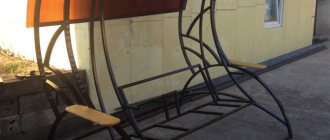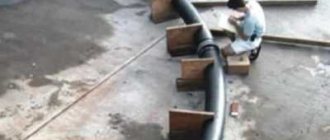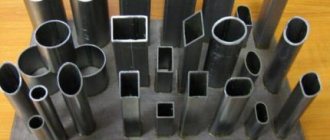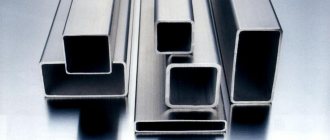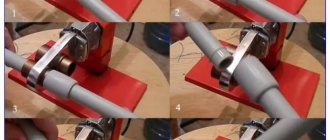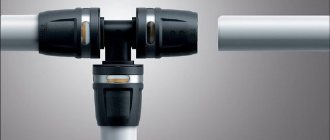Bending pipes with your own hands is permissible only in one-time cases.
If the process of assembling a metal structure or pipeline involves the use of a large number of “bent” pipes, then the process of deforming the products is best carried out on special machines - pipe benders. However, in this article we will consider both options for pipe deformation, trying each method on products of different shapes and diameters.
Pipe bending equipment
Plane-parallel plates
If heating and cooling is not your thing, use a parallel plate.
A primitive, but trouble-free and proven method. A plate is a curved piece of wood or metal with a groove. Suitable for working with steel and metal-plastic products with a diameter of up to 45 mm. Operating principle:
- We place the pipe in a clamp on a plane-parallel plate and fix it (clamp it).
- We bend it, repeating the shape of the workpiece along the groove, and remove it.
A fast, reliable method that does not require large expenses. The disadvantage of using plane-parallel plates is the unchangeable curvature of the workpiece. The use of plates with different radii of curvature will help solve the problem. A steel structure will also give in.
The peculiarity of the method is the limitation in length; the shape of short tubes can be easily changed, but it will not be possible to accurately bend a product whose length exceeds the length of the workpiece.
A plane-parallel plate is a reliable, affordable way to bend a pipe yourself
Let's look at how to bend a pipe into a spiral with your own hands or give the product an angle of up to 90°.
It is better to use a metal spring for working with parts made of ductile non-ferrous metals. The spring prevents deformation of the structure. The choice of size depends on the internal “girth” of the tube.
How to proceed:
- Insert the spring into the part (insert until it bends).
- Gradually add a bend at the knee or by first clamping the structure in a vice.
The spring simplifies the process by taking the compression/tension force and load onto itself. When working with soft, pliable materials, choose springs of medium hardness and small diameter
Precautionary measures will prevent the part from bursting or tearing
Metal springs serve as a “frame” for the pipe when bending
Radical measures - welding
Bending of metal sheets and pipes is also carried out using a grinder. Welding is a radical method that solves the problem if other options are not suitable for objective reasons. The required tools are a welding machine and a grinder.
Algorithm of actions:
- Make calculations - estimate the radius of curvature of the product (to be sure, you can sketch out a drawing and make markings on the part).
- Three transverse cuts are made along the length of the bent section (on three sides).
- The details give a bend.
- The sawn sections are welded.
- The bent end of the pipe at the welding site is ground, removing “sawdust” and irregularities.
The bend is neat, aesthetic and durable.
As you can see, there are enough answers to the question of how to bend a pipe - choosing the method that is relevant to solve your problems will not be difficult. All you need is the right tool and desire. Consider the diameter of the product, its length and the material with which you will be working.
The above methods have two disadvantages:
- Possibility of product damage, breakage and ruptures.
- Getting a uniform, aesthetic curve at home is problematic.
Welding is a quick way to give a pipe the desired bend.
There is only one way to insure yourself against troubles if you do not have the skills and experience in pipe bending work - to hire a professional.
If you have no desire or opportunity to use the services of a specialist, do not despair. Before starting the event, carefully study the mat. part, watch videos or master classes from professional builders (there are plenty of them on the Internet).
Basic techniques for bending pipe parts
Bending of pipe parts is carried out in cold and hot states by manual and mechanized methods, with and without fillers.
Fillers are used to prevent the formation of folds and flattening of pipe walls. Dried fine sand or synthetic granules are used as fillers.
For each pipe, depending on its diameter and material, the minimum permissible bending radius is established. With a smaller radius, bending is unacceptable (Table 1).
Table 1. Values of the minimum permissible bending radii of pipes in a cold state, mm
| Pipe outer diameter, mm | Pipe material | Pipe outer diameter, mm | Pipe material | ||||||
| Steel 45 | Steel 35 | Steel 20 | Steel 10 | Steel 45 | Steel 35 | Steel 20 | Steel 10 | ||
| 18 | 74 | 62 | 56 | 43 | 105 | 450 | 344 | 282 | 240 |
| 24 | 95 | 79 | 65 | 55 | 110 | 510 | 377 | 310 | 264 |
| 32 | 115 | 96 | 79 | 67 | 130 | 536 | 450 | 370 | 315 |
| 38 | 156 | 131 | 107 | 91 | 145 | 578 | 484 | 398 | 339 |
| 50 | 197 | 165 | 136 | 115 | 155 | 620 | 522 | 430 | 360 |
| 60 | 238 | 199 | 165 | 139 | 181 | 720 | 600 | 498 | 425 |
| 75 | 280 | 260 | 194 | 173 | 194 | 752 | 630 | 516 | 444 |
| 80 | 324 | 270 | 224 | 190 | 206 | 835 | 702 | 575 | 488 |
| 90 | 362 | 302 | 250 | 213 | 220 | 920 | 770 | 635 | 540 |
When cold bending pipes with a diameter of up to 25 mm, hand tools are used.
In Fig. 4, a shows a manual machine designed for bending pipes with a diameter of 12 to 20 mm. The machine has an axis 1 and a base plate 2, with which it is bolted to the workbench. The working parts of the machine are a fixed roller 4 with a clamp 5, mounted on axis 1, and a movable roller 3, mounted on a bracket 6 with a handle 7. The end of the bent pipe is placed in the clamp between the rollers, then the bracket with the movable roller is rotated around the axis of the fixed roller until the required bend, after which the bracket is returned to its original position and the pipe is removed.
Rice. 4. Bending using hand tools
To bend copper tubes of different diameters when assembling machines, a multi-strand pipe bender (5.66, b) is used. In this case, the tube is passed between rollers 1 and 2 until it comes into contact with the stop, then when the fork 3 is turned, the movable roller 2 rolls around the stationary one, bending the tube along a radius equal to the radius of roller 1.
Using a manual lever pipe bender (5.66, c), you can bend steel gas pipes with a diameter of 1/2, 3/4 and 1" in a cold state without filler.
For manual bending of steel pipes with a diameter of up to 50 mm at an angle of 180° without filler in a cold state, a special head with a manual drive can be used.
Reel bending
This method has become widespread in industrial production due to its relative simplicity, low energy consumption and the yield of high-quality products. In this case, internal filling is used, most often it is a metal rope with a diameter 0.1–0.5 mm smaller than the internal diameter of the workpiece. When a rope bends, it can leave a mark on the inner surface of the pipe, so ropes made of thin woven metal fibers of non-hard grades of metal are used.
Also, when using this method, a lubricant is required between the rope and the inner surface, which is usually machine oil or anti-corrosion soap emulsion. You can bend pipes with a diameter from 10 to 425 millimeters in different planes. Therefore, for large diameters, the cable is not used, but, if possible, is replaced with a bulk or liquid substance.
By running in
The method is that a rolling roller moves around a roller or support of the required dimensions, a workpiece is placed between them and a bend is obtained. In a similar way, you can work with pipes with a diameter of up to 150 millimeters with thick walls.
Flaring and Rolling
First of all, it should be understood that pipe flaring cannot be called rolling, since the essence of these technological operations is completely different.
- Rolling, for which a special rolling machine is used (a machine equipped with work rolls), is a technological operation during which rolled sheet metal or a metal pipe is deformed in the radial direction. Using this operation, in particular, products of cylindrical or conical shape are formed from sheet metal, and products with a different cross-sectional shape are also made from round rolled pipes.
- The flaring tool does not contain work rolls in its design, and the essence of the procedure itself is that only the end of the pipe is subjected to plastic deformation, while its internal and external diameters increase to the required parameters. The need to perform such an operation most often arises in cases where two sections of pipe need to be securely connected to each other.
Types of tube flaring
To obtain a reliable and tight connection between two pipes, various methods are used - soldering, the use of union couplings and other fitting elements, etc. In some of these cases (particularly when soldering and using slip-on couplings), the ends of the tubular products need to be widened. To perform this procedure, a flaring machine is required.
Many home craftsmen also mean by flaring other technological operations, the purpose of which is also the plastic deformation of a separate section of a pipe product. This includes, for example, rolling and bending.
- Rolling is a procedure that does not imply expansion, but narrowing of the edge of the pipe. In this case, a simple crimping method is used, for which ordinary pliers or miniature rollers are used. The need to perform such an operation arises in cases where it is necessary to cut a thread at the end of a pipe using a hand tool.
- Bending is a technological operation for which special devices with working rollers are used and which is often also called flaring, although this is fundamentally incorrect. The purpose of bending, which can be applied to both soft copper tubes and rolled pipes made of steel and other metals, is not to expand, but to bend a separate part of the product at the required angle.
Flaring tubes during air conditioner installation
Heat treatment method
As for the metal pipe, your assistant should be a gas burner. We act in stages.
- Using a vice, the metal section of the pipe is fixed.
- The intended bend area is heated using a gas burner.
- After the scale appears, we bend it.
It is important to catch the moment the bend begins. If the pipe is aluminum, then you need to bring a sheet of paper to it
If it lights up or starts smoking, then you can start. If the pipe is made of another metal, then the signal will be the area that turns red during the heating process. The heat treatment method cannot be used when bending galvanized pipes. High temperatures will damage the coating and render the coating unusable. You need to know that if we are talking about bending a square pipe, then you cannot do without a powerful blowtorch or torch. And the main thing is that at the very beginning of work such a product warms up from all sides.
Bathtub made of wood in the interior: photo
Varieties of processing methods for sheet steel
Since they work with sheets most often, we will dwell on them in more detail. The classification is based on the drive. He can be:
- Manual - this takes a lot of time, so it is more often used in small industries and for private purposes. The main tools are a hammer and pliers or a mallet if the layer is very thin. There is no need to talk about high accuracy; everything is done almost by eye, but for small parts this is often enough.
- Automatic – equipment equipped with a control panel and an electric drive is used. Excellent for mass production. The operator only installs the workpiece and monitors the correct execution of the process.
Types of bending machines
Before bending an aluminum angle, steel pipe or metal sheet, you need to select equipment for the work. Metal bending is performed on different types of machines:
- Manual models. This is equipment for placement in private workshops. It has small dimensions and does not require additional skills to carry out the work. Using hand tools, you can bend metal sheets and parts of small thickness.
- Mechanical models. They are a structure that is driven by energy transmitted from the flywheel. Initially, the master must unwind this element.
- Hydraulic machines. The equipment contains a hydraulic cylinder.
- Electromechanical units. Common industrial machines that operate using an electric motor. It drives other mechanisms using belts and gears.
- Pneumatic models. This is a design whose mechanisms are driven by pneumatic cylinders.
- Electromagnetic machines. Powerful electromagnets are used to operate the equipment.
On sale you can find mobile devices for bending metal sheets and parts. They are used in garages, private homes, and workshops.
How to use a pipe bender at home
Pipe benders are special mechanisms that are characterized by different operating principles. With their help, manual and mechanical bending of profile and round pipes is carried out in production conditions or at home.
There are the following types of manual pipe benders suitable for bending plastic thin-walled aluminum products with a small diameter:
- Lever. This mechanism is also called the Volnov machine. It has a special form for inserting the workpiece. The bending process itself does not require heating the pipe, and is carried out by lever force. The shape corresponds to a specific diameter.
- Crossbow. The structure in which the workpiece is secured is equipped with a bending segment that pushes through the middle of the pipe on the side opposite to the ends.
- Spring-loaded. Before bending, the pipe is equipped with a spring, which is placed inside the product. Next, the workpiece can be heated, or a cold bending method can be used. At the end of the procedure, the spring must be removed.
With the help of machine bending, it is possible to solve the problem of how to bend and how to straighten an aluminum tube of various diameters and shapes. The risk of damage is reduced to almost zero.
These mechanisms can have an electromechanical or hydraulic operating principle, which guarantees an accurate result of the work in accordance with the requirements.
GOST 17365-71 Handbook on cold stamping
The minimum pipe bending radii R must be:
- for pipes with an outer diameter of up to 20 mm, not less than...2.5D
- for pipes with an outer diameter over 20 mm, not less than...3.5D (where D is the outer diameter of the pipe).
The thinning of the walls in places where pipes bend and where curved sections transition into straight ones should not exceed:
- for steel pipes – 20% of the original wall thickness
- for aluminum alloy pipes – 25% of the original wall thickness.
The thinning of the walls of pipes stamped from sheets should not exceed 15% of the original sheet thickness.
Smallest bend radius
Bending radii along the pipe axis. Bending without filling or melting. For smaller bending radii, bending should be done with reflow or filling.
Designations: D—pipe diameter; S - pipe wall thickness
To contents
The smallest radii and shortest lengths of straight sections of curved pipes are shown in Fig. 1.
The length of the curved section of pipe A is determined by the formula:
Where R is the smallest bending radius, mm; dн – outer diameter of pipes, mm.
When choosing a bend radius, you should prefer to bend pipes in a cold state whenever possible.
The shortest length of a straight pipe section Lmin is necessary to clamp the end of the pipe when bending
Bending radii of copper and brass pipes manufactured according to GOST 617-90 and GOST 494-90, respectively (see Fig. 1)
Outer diameter dн
Smallest bend radius R
Minimum length of straight section Lmin
Bending radii of steel water and gas pipes manufactured according to GOST 3262-75 (see Fig. 1)
Nominal diameter Dy
Outer diameter dн
Smallest bend radius R
Minimum length of straight section Lmin
Hot
Cold
Bending radii of steel pipes depending on their diameter and wall thickness Dimensions, mm
Pipe diameter, d
Smallest bending radius for wall thickness
IN AND. Anuriev, Handbook of mechanical engineering designer, volume 3, pp. 368-369., Moscow 2001
Bend as a negative factor
When bending, the pipe is deformed
Pipe bending is detrimental to performance. There are various disadvantages depending on the material, bending angle, bending device and method, internal diameter and thickness of the material. Negative consequences include:
- a change in the bend radius during operation under the influence of thermal expansion or contraction and mechanical action, resulting in a springing effect; a decrease in the thickness of the outer wall at the bend; the appearance of sharp breaks or accordion-shaped folds on the inner wall of the bend; ovalization - a change in the shape of the pipe and the appearance oval-shaped lumen; increased exposure to corrosion on the inner and outer walls of the bend.
When a substance passes through the internal cavity of the pipe, special pressure is exerted on the outer wall, therefore, when installing in places where liquids flow at high pressures, it is recommended to use an elbow, thickening or a pipe with thicker walls.
The resulting ovalization also negatively affects the pipes during rapid fluid flow. In such places, there is a narrowing along one axis and expansion along the other, which, in turn, also increases the pressure on the outer wall of the bend. You also need to take ovalization into account when laying pipes in narrow places, since its width at the bend increases.
Scheme of deformation during pipe bending
There are two ways to prevent ovalization and maintain a round shape during cold bending. First, support the walls from the inside using an internal stop. Second, support the walls both from the inside and outside, using an internal and external stop.
The internal limiter can be sand, rubber, water, resins or fusible materials carefully compacted into the pipe. The main thing is to securely close the pipe holes so that when the pressure increases during bending, the filler does not fall out. If possible, it is recommended to seal the pipe openings tightly.
When using the second method, the integrity indicators are slightly higher, but this requires special mechanical elements or tanks, which are usually used in the industrial production of pipes. If a more rigid and solid internal filling is used, a more round shape of the lumen will be maintained, so they are used more often. But when using elastic fillers, the outer side is less stretchable.
Bending a stainless steel pipe in a homemade device
In production, when it comes to bending stainless steel pipes, cold bending is usually used due to higher profitability, and in cases where hot bending is necessary, it is often more profitable to simply pour the required shape right away. Therefore, the following are methods of cold bending, especially since most technologies are not very different from the hot method.
Manual pipe bending
To avoid defects during the work of bending metal-plastic products, it is necessary to have sufficient physical strength and strictly follow a certain technology.
So, you need to bend the pipe manually as follows:
- We take a piece of pipe with both hands at the ends of the intended bend;
- carefully bend to an angle of 20º;
- shift the pressing force to the right or left of the formed angle;
- make a 20º bend again;
- We make several small mini-bends until the desired angle of the workpiece is achieved.
Bending a pipe in one step can lead to breakage of the workpiece. To maintain a given angle, you need to bend the pipe a little more and then return it to its original position
If you want to straighten the pipe, all operations must be done in reverse order, taking special care. This method is easily used for pipes with a diameter of up to 20 mm, but it will be difficult to make blanks of a larger cross-section by hand
Manual method
Manual pipe bending
In home construction, it is better to use special pipe benders. But it is necessary to take into account the possible undesirable consequences described above.
Note! For less lumen deformation, internal fillers should be used.
Application of bent stainless steel pipe
We also recommend that you read articles that describe methods for bending other pipes:
Bending a pipe using a spring
With this method, the role of a shock absorber is performed by a spring of the required diameter. It is the spring ribs that protect the reinforcing layer of the pipe from wrinkling and damage. Typically, such a device is sold in pairs (external and internal parts). The diameter of the device is selected to match the size of the workpiece, and it is better to choose a spring with O-rings.
To make it easier to insert the pipe into the outer part of the spring, the manufacturer widened one end. The inner spring has one tapered end that allows easy access to the bend, and a loop on the other end for easy removal of the spring after use.
Spring bending technology:
- tie the cord to the loop and insert the inner spring into the pipe;
- the external spring is put on the workpiece;
- smoothly bend the pipe to the desired angle;
- At the end of the bend, open the corner a little and remove the device.
In order for the polyethylene inside the pipe to bend evenly, the entire process must be carried out carefully, with smooth swinging movements. The same technological principle lies in bending a pipe using wire. The restraining element is a piece of soft wire of a suitable cross-section. The main thing is not to forget to tie a cord to one end in order to remove the wire after work.
How to bend a metal-plastic pipe
So, let's start by looking at how to bend metal-plastic pipes. Usually, when installing such pipes, you need to make a lot of smooth bends on them. This will help you make the most of all the capabilities of such a product.
How to make the bend extremely smooth and even? Everything is quite simple, you just need to read the options below:
So, the first and easiest option is smooth manual bending of the pipe. If you decide to bend the pipe in this way, be sure to remember that the bend for every 2 centimeters should be around 20 degrees, or at least within their limits. This is how you can make all the necessary bends on the product.
The next method is more complicated, but it is no less effective. In order to bend a pipe in this way, you need to prepare several pieces of wire of a fairly small size, with the help of which you need to fill the entire internal space of the pipe until it stops. By completely filling the pipe with wire, the bends will be as even and smooth as possible.
These are the two simplest and most common methods; if you are interested in more complex options, go online. Fortunately, there are plenty of different ways.
Advice! If it seems to you that you will not be able to bend the product with the highest quality and without flaws, it is better to contact professionals in their field. This way you will save not only your time, but also the product. Moreover, such work is relatively inexpensive.
Pipe bending equipment
The question of how to bend a pipe without a pipe bender will not cause difficulties if you use the simplest devices to perform this operation. You can perform cold bending of pipes using the following devices.
- In cases where it is necessary to bend a soft (aluminum) or steel pipe with a profile height of no more than 10 mm, a horizontal plate with holes is used into which stops - metal pins - are inserted. Using these pins, products are bent according to the required parameters. This method has two serious drawbacks: low bending accuracy, and also the fact that when using it it is necessary to exert significant physical effort.
- It is better to bend products with a profile height of 25 mm using roller devices. The pipe is securely fixed in a vice, and force is applied to the part that needs to be bent using a special roller. This device allows you to get a better bend, but also requires physical effort.
The option, as they say, is a quick one. The long lever of this extremely simple device allows you to cope with fairly thick pipes
To form a bend with a large radius of curvature on steel or aluminum professional pipes, stationary round templates are used, on which special clamps are mounted to fix the product. Using such a device, the pipe is also bent manually, placing it with force into the groove of the template, the shape of which exactly corresponds to the required bending radius.
Plywood and metal staples are all you need to make a bending template
Bending plate
To effectively bend steel or aluminum pipes at home, you can make an upgraded bending plate using the following guidelines.
- The role of such a plate is played by a panel cut from thick sheet metal.
- The panel made in this way is welded to a stand, which is installed on a special pedestal.
- Two holes are drilled in the panel, which are necessary for installing bolts that serve as stops for the profile pipe.
- A special attachment is installed on one of the stop bolts, with the help of which the bending radius is adjusted.
- To ensure the alignment of the pipe sections adjacent to the bend, a metal plate is placed above the workpiece, secured with bolts.
Mandrel bending
For bending profile pipe products at home, the wall height of which does not exceed 25 mm, you can make a special mandrel. For these purposes, it is better to use a large workbench, on the surface of which there will be enough space for such a device. To select the optimal location for the element securing the bent pipe, frequently spaced holes are made at one end of the workbench. A special template is responsible for ensuring the required bending radius of the corrugated pipe, which can be made from thick plywood or a metal corner if you are going to use it often.
Application of profile bending machine
Of course, if you have a significant amount of work to do on bending profile pipes, it is better to make a special machine for this, the drawings of which are easy to find on the Internet. We will not discuss this issue here, since it is discussed in more detail in the articles linked below.
You cannot do without such a machine even if you need to bend pipes with a large profile cross-section. The main working parts of such a machine, which is distinguished by its wide versatility, are three rolls, two of which are fixed motionless, and by changing the position of the third, the bending radius of the product is adjusted. The drive of such a device is a chain drive and a handle that the operator rotates.
Curved pipes may be needed when installing heating appliances, plumbing fixtures, when installing pipelines in the house, etc. If you have not purchased the necessary pieces of pipe that have already been bent, you can bend them yourself at home. The only thing that can go wrong is the pipe bending inward and breaking, since when bent, the metal of the product experiences both compression and tension at once. To prevent this from happening, you must adhere to the following tips.
Bending with or without homemade equipment
This option is common since a jack is a very popular tool that most motorists have. It is perfect for bending rolled metal at home. The operating principle of this method is similar to a crossbow pipe bender. The pipe is fixed at three points, two of which are stops, and the third is the jack rod.
Using an angle grinder (grinder) to bend profile pipes
This method works with a rectangular section profile. Several cuts are made along three walls, the fourth remains untouched. Due to the appearance of cuts, the pipe is easily bent, after which the cuts are welded and ground.
Homemade roller pipe bender
Excellent for obtaining large diameter bends on profile pipes. It is convenient for them to bend, for example, a pipe for greenhouses. A piece of metal is fixed on rollers, pressed, and rolled. Then it is pressed again and rolled again. The result is a large, uniform bend radius.
Auxiliary methods for pipe bending
Filling
A filler is placed into the pipe to fill the internal space. In this case, the ends are tightly sealed; welding can be used for this. The use of filler allows you to “fix” the internal volume. When bending, avoid the appearance of a “wave” or “corrugation” on the inside of the corner and make the bend smoother. Pure quartz sand is often chosen as a filler.
Heat. Increasing the ductility of metal when bending
Heated metal becomes softer the higher its temperature. The metal of the pipes is heated using gas burners, induction heating, and any other available method. The heating temperature depends on the metal. Low alloy and ordinary standard steel heats up to ~500 degrees Celsius.
Using these methods, you can bend a metal pipe with your own hands at home without the use of specialized equipment and get good results.
Stages and sequence of technology
Here, and in the future, we will talk about the processes of stamping sheet metal in a cold state. Development is carried out in the following sequence:
- The design of the part is analyzed.
- The force and work of the process are calculated.
- The standard size of production equipment is selected.
- A drawing of the initial workpiece is being developed.
- Strain transitions are calculated.
- Technological equipment is being designed.
An analysis of the compliance of the capabilities of the source material is necessary in order to determine its suitability for stamping according to the dimensions shown in the drawing of the finished part. The stage is performed according to the following positions:
- Checking the plastic ability of the metal and comparing the result with the level of stress that occurs during bending. For low-plasticity metals and alloys, the process has to be split into several transitions, and between them, interoperational annealing must be planned, which increases plasticity;
- Possibility of obtaining a bending radius at which cracking of the material will not occur;
- Determination of probable distortions in the profile or thickness of the workpiece after pressure treatment, especially with complex contours of the part;
An obligatory point when developing a technological process is the calculation of the minimum permissible bending angle, bending radius and springback angle. The bending radius rmin is calculated taking into account the plasticity of the workpiece metal, the ratio of its dimensions and the speed at which deformation will be carried out (hydraulic presses, with their reduced speeds of movement of the slide, are preferable to higher-speed mechanical presses). As the rmin value decreases, all metals undergo so-called thinning—a decrease in the original thickness of the workpiece. The intensity of thinning determines the thinning coefficient λ, %, which shows how much the thickness of the final product will decrease. If this value turns out to be more critical, then the initial thickness s of the workpiece metal has to be increased.
For low-carbon sheet steels, the correspondence between the above parameters is given in the table (see Table 1).
Table 1
Thus, under certain conditions, the metal of the workpiece may even bulge somewhat.
No less important is the determination of the minimum bending radius, which also depends on the initial thickness of the metal, the location of the rolled fibers and the ductility of the material (see Table 2). If the bending radius is too small, the outer fibers of the steel may break, compromising the integrity of the finished product. Therefore, the minimum radii are usually calculated based on the greatest deformations of the extreme parts of the workpiece, taking into account the relative narrowing ψ of the deformed material (established according to tables). In this case, the amount of deformation of the workpiece is also taken into account. For example, for small deformations, use the dependence
and for large deformations, a more accurate equation of the form
table 2
The effect of probable springback can be taken into account using data on the actual springback angles β, which are given in Table 3. The data in the table correspond to the conditions of single-angle bending.
Table 3
What can be bent and what can’t
Many compatriots are wondering whether it is possible to bend polypropylene pipes and how to do it correctly ().
Let's consider which materials are subject to mechanical deformation without harm to subsequent operation, and which are not.
Almost all rolled metal can be bent, including aluminum, copper and steel pipes of various diameters. It is more difficult to change the configuration of products made of stainless steel and similar hard alloys.
To properly deform all metals without exception, you need a special machine for bending pipes. Using a special machine will not only ensure optimal bending quality, but will also allow you to complete the task with minimal physical effort.
Some plumbers, to save fittings, heat the polypropylene with an industrial hair dryer and bend it to the required shape. It is not advisable to do this, since due to deformation in combination with heating, the curved plastic pipe will have uneven wall thickness on the outer and inner radius.
As a result, the operation of the constructed water pipeline will not last long, since under the pressure of the liquid medium, cracks will appear in the thin wall over time.
Choosing the right tool
A spring is an effective tool for working with plastic. There are two types of springs on the market: external and internal. Both types of tools are distinguished by an affordable price. The tool must be selected in accordance with the outer or inner diameter of the pipe.
The device is made of polished steel. The smooth surface of the coils allows you to remove the spring from the bent pipe. The use of a spring makes it possible to ensure the same cross-sectional diameter throughout the bend.
A pipe bender is a wide range of machines or devices designed to deform rolled metal, taking into account the required angle and bend radius. The devices are actively used in the construction of pipelines for various purposes of various configurations and sizes.
Classification of pipe benders
All modern pipe benders meet the following requirements:
- the ability to bend at an angle of up to 180 degrees;
- ability to work with pipes made of various materials, including aluminum, copper, steel and polymer compositions.
Such equipment is divided into the following categories according to the type of drive used:
- Manual modifications
are usually used for working with small diameter pipes. The device is driven by a collar, to which significant muscular force is applied. - Hydraulic modifications
are the best choice for working with pipes whose diameter does not exceed 3 inches. The operation of hydraulic devices allows you to work with pipes without excessive physical effort. There are mobile and stationary hydraulic pipe benders on the market. - Electromechanical modifications
are presented on the market as universal devices designed to perform high-precision bending. The main advantage of such pipe benders is the ability to work with thin-walled metal without the threat of damage.
In accordance with the bending method and the configuration of the working part, the tool can be:
Crossbow, where a replaceable metal guide mold is used as a deforming element, which is selected for a certain pipe diameter.
Segmental, where rolled metal is pulled out by a special segment that wraps the pipe around itself.
In the photo - a mandrel machine
Dornov, where work with rolled metal is carried out both from the outside and from the inside of the pipe. This feature allows the device to be used to change the configuration of thin-walled pipes without the threat of metal rupture or the formation of folds along the internal diameter.
Pipe bending technology
The instructions for changing the pipe configuration using an external spring are as follows:
- The spring is put on a metal-plastic one;
- Then the pipe is grabbed with both hands at a distance of 20 cm from the spring and bent until the desired angle is obtained;
- After the desired angle is obtained, the spring is rotated around its axis and removed.
The use of an internal spring differs in that the device is inserted from the edge of the pipe, where it can then be pulled out.
The bent end of the pipe can be obtained using a pipe bender. In this case, the device, in accordance with its modification, is configured to the required parameters. The pipe is then inserted into the receiving gap and the device is driven by one or another drive.
What is trenchless pipe laying and how does it work?
The essence of the method is to draw a highway under the surface of the earth, as opposed to digging surface trenches, which have the following disadvantages:
- Removing soil leads to the destruction of the upper fertile layer not only in the trench, but also by special equipment, as well as to contamination of the surrounding area, which significantly increases the scale of damage.
- With the trench method, plantings (trees, shrubs) are damaged, which cannot always be restored.
- When carrying out work on asphalt roads and pedestrian roads, the asphalt coating is destroyed, the use of the routes becomes impossible and further repairs are required - this brings inconvenience and is not economically profitable.
The advantages of the trench method include the simplicity of the technology, available in households, and the prevalence of the equipment used; also, digging trenches does not require highly qualified workers.
When using the trenchless method, installation and laying of the pipeline is carried out using drilling equipment, pass-through units, hydraulic and pneumatic punches.
